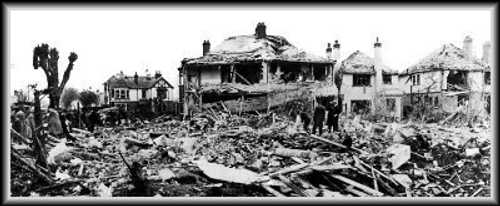
Homefront
BRITAIN'S FIRST CIVILIAN CASUALTIES
On April 30, 1940, anti-aircraft fire shot down a German Heinkel 111 bomber while on a mine laying sortie off the east coast of England. The bomber crashed onto a house in Upper Victoria Road in Clacton-on-Sea in Essex killing the occupants, Mr. and Mrs. Frederick Gill. They became the first civilians, of more than 60,000 killed in England during the war. Frederick and Dorothy Gill were buried in an unmarked grave in the Burrs Road Cemetery. In 1994, the grave site was discovered and a proper Commonwealth War Graves Commission headstone was erected and dedicated on the 59th anniversary of their deaths. The German aircraft was actually on a mine laying operation over the North Sea, but the crew became disorientated due to heavy fog. Flying blindly until just before midnight the Heinkel crossed the coast near the radar station at Bawdsey in Suffolk. Anti-aircraft batteries along the coast at Bawdsey, Felixstowe and Harwich opened fire on the bomber. Ironically, the Heinkel did not receive a direct hit, but it is thought that exploding shells underneath the aircraft caused considerable damage to the aircraft controls. Eyewitnesses have said that it does appear that the pilot tried desperately to find a landing area because he released flares as his plane circled Clacton and Holland-on-Sea before flying out to sea again, then returning at a considerably lower altitude. The German bomber hit the chimneys of a number of houses before crashing on the house occupied by the Gill family. After the bomber crashed, the live mine that it was carrying exploded and this is what caused the unintentional, but spectacular damage. The next civilian killed in an air raid on Britain was James Isbister during a German raid on Scapa Flow in the Orkneys on March 16, 1940. A bomb fell near The Bridge of Waith, killing 27 year old Isbister. On a previous raid on November 13, 1939, during an attack by a Heinkle bomber on the Shetland Islands, all that resulted was a large bomb crater in the countryside and the only fatality was a rabbit, which gave rise to the famous WWII marching song 'Run Rabbit, Run'. There is some speculation that the rabbit was actually purchased from a local butcher and placed in the crater for effect ... or a laugh; but either way, this must be the world's most famous dead rabbit! Greetz,brummbar
2586 Views
11/11/2011
